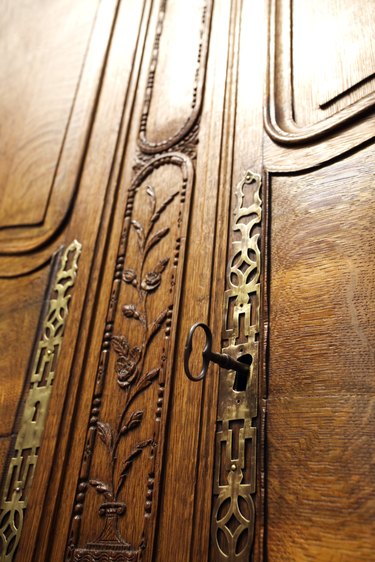Things You'll Need
Screwdriver
Hammer
Drill
Skeleton key
Tin
Scissors
Vice
Metal file

Mortise locks can be found in older buildings, and are often rehabilitated due to their quality, antique value and old-fashioned look. The lock's name comes from the pocket, or the mortise, which is cut into the door to fit the lock. With the advent of modern cylindrical locks, the mortise is now most commonly used on upscale or commercial properties that require frequent rekeying. Mortise locks can be more than 100 years old. Many were fitted with skeleton keys or keys made in simple designs that can easily be replaced with a master key by most locksmiths. Replace the cylinder yourself to get a new key or make your own replacement key.
Replace the Key
Step 1
Examine your old mortise lock carefully to see if there is a manufacturer name and model number. Check for such brand names as Corbin P series (P1 to P12), Brinks, Baldwin or Sargent & Co.
Video of the Day
Step 2
Look online for replacement parts sold by lock companies or individuals if you can identify the manufacturer. If you cannot identify the manufacturer, carefully open up the lock by unscrewing it from the pocket.
Do not try to open an old mortise lock on a locked door with grinding tools, as this can shatter your grinder. A locksmith can pick your lock and open it without damage to your door or the lock, and can then rekey the lock.
Step 3
Convert your mortise lock to a modern lock with a conversion backplate kit that includes instructions and all parts, including a key. If you cannot unscrew your old lock, you may need a locksmith to remove the old mortise lock before installing the conversion kit yourself.
Make a New Key
Step 1
Make your own hand-filed skeleton key. Remove your mortise lock's panel to get into the locking mechanism. Examine the lock carefully, since every lock is different.
Step 2
Remove the keyhole from the lock and put it in a vice. Use a metal saw around the keyhole to get into the metal casing. Look at the key pattern to see all the standing pins that control the lock. Carefully remove only the top set of pins.
Step 3
Insert a blank skeleton key through the keyhole and onto the bottom set of pins. The bottom pins will stand up through the keyhole.
Step 4
Fabricate a key by putting the original key or a skeleton key on a flat piece of tin. Trace the outline onto the tin. Cut out the tin with heavy-duty scissors. Hold the keys together using a small vice. File the tin into the shape of the original key and adjust it until the tin key fits into the mortise lock.
Step 5
File the skeleton key or tin key down with a metal file until the pins all lay flat at the top of the keyhole. Keep making small adjustments with the file until the key fits perfectly.
Tip
Use graphite to lubricate any parts on your old lock.
Warning
Metal fatigue can make your old lock’s internal parts brittle and render the lock useless. If your lock is too old, replace any moving parts along with the key.
Video of the Day